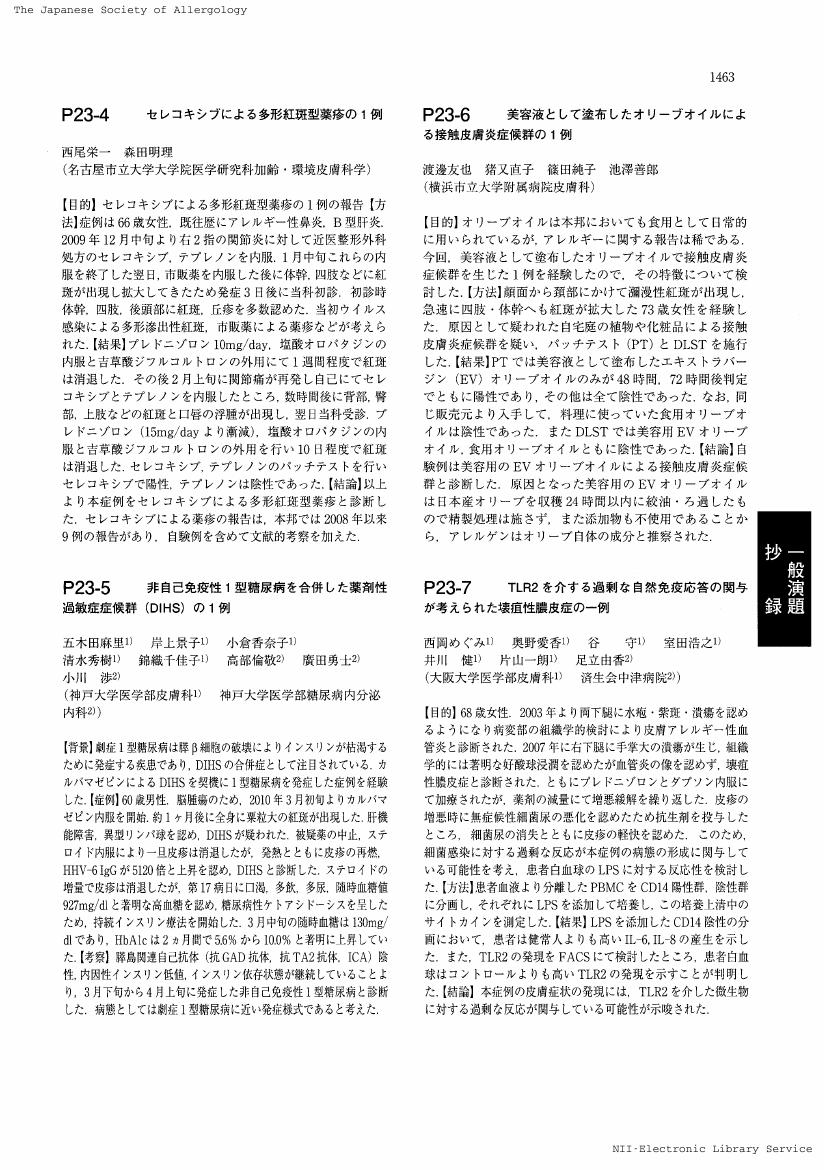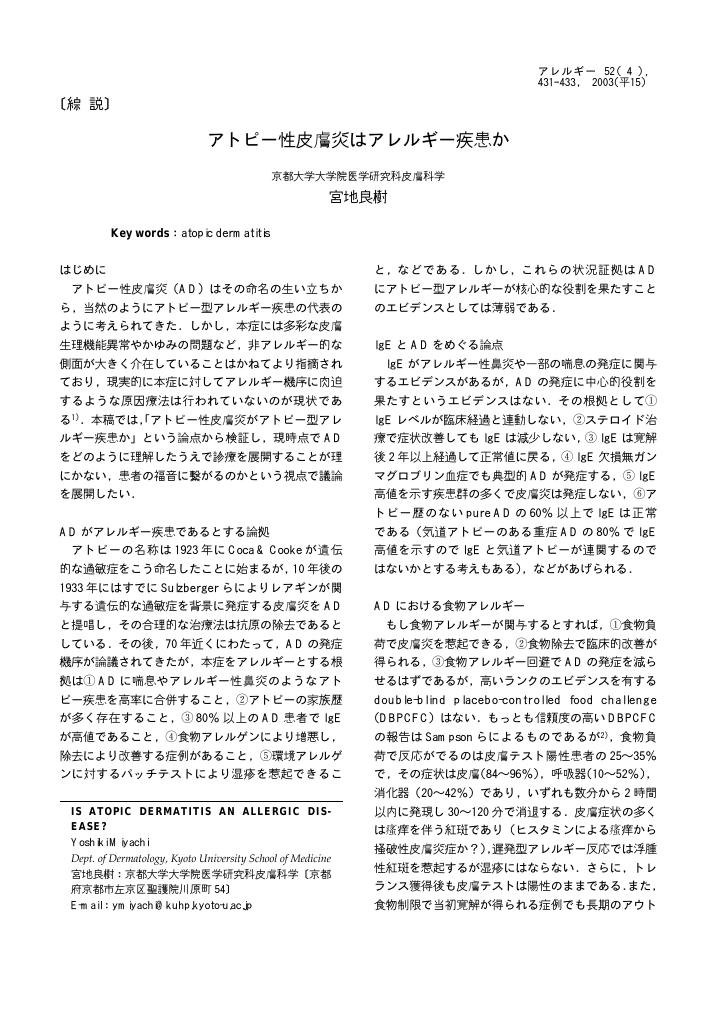3 0 0 0 OA 3.新生児・乳児消化管アレルギー・好酸球性消化管疾患 ~広義の消化管アレルギー~
- 著者
- 山田 佳之
- 出版者
- 一般社団法人 日本アレルギー学会
- 雑誌
- アレルギー (ISSN:00214884)
- 巻号頁・発行日
- vol.68, no.9, pp.1102-1109, 2019 (Released:2019-11-12)
- 参考文献数
- 34
3 0 0 0 OA JAK キナーゼ
- 著者
- 朝比奈 昭彦
- 出版者
- 一般社団法人 日本アレルギー学会
- 雑誌
- アレルギー (ISSN:00214884)
- 巻号頁・発行日
- vol.67, no.2, pp.157-158, 2018 (Released:2018-03-16)
- 参考文献数
- 8
3 0 0 0 OA 3.喘息死
- 著者
- 山内 広平
- 出版者
- 一般社団法人 日本アレルギー学会
- 雑誌
- アレルギー (ISSN:00214884)
- 巻号頁・発行日
- vol.65, no.10, pp.1248-1256, 2016 (Released:2016-12-27)
- 参考文献数
- 13
3 0 0 0 OA 納豆による遅発性アナフィラキシーを繰り返した1例
- 著者
- 鈴木 慎太郎 中村 陽一 川野 豊 西岡 清
- 出版者
- 一般社団法人 日本アレルギー学会
- 雑誌
- アレルギー (ISSN:00214884)
- 巻号頁・発行日
- vol.55, no.7, pp.832-836, 2006-07-30 (Released:2017-02-10)
- 参考文献数
- 5
- 被引用文献数
- 1
症例は22歳の男性.アナフィラキシーショックで当院に搬送され,直前の食事内容と既往歴より青魚による食物アレルギーが当初最も疑われた.以後,抗原除去を指示して外来経過観察していたが,翌月,翌々月にもアナフィラキシーで来院したため,より詳細な問診を実施したところ被疑抗原として納豆が考えられた.精査入院し,抗原負荷テストを施行し,納豆50gを摂取後9時間後に膨疹など皮膚症状や胸痛を主としたアナフィラキシーが再現され,納豆による食物アレルギーと診断した.ここ数年,納豆によるアナフィラキシーの報告が散見され,摂取後半日経過してから症状を呈する「遅発性」アレルギーと称される特徴的なパターンを示すことが多いとされる.日本の伝統食品でもある納豆は近年海外でも健康食品として注目されており,納豆アレルギーの存在が周知されることが望ましい.
3 0 0 0 OA エンドトキシンを引き金としたIgE非依存性鼻炎症状の誘導
- 著者
- 岩﨑 成仁 善本 知広
- 出版者
- 一般社団法人 日本アレルギー学会
- 雑誌
- アレルギー (ISSN:00214884)
- 巻号頁・発行日
- vol.66, no.7, pp.936-944, 2017 (Released:2017-08-18)
- 参考文献数
- 38
- 著者
- 川合 眞一
- 出版者
- 一般社団法人 日本アレルギー学会
- 雑誌
- アレルギー (ISSN:00214884)
- 巻号頁・発行日
- vol.58, no.1, pp.7-12, 2009-01-30 (Released:2017-02-10)
- 参考文献数
- 11
- 被引用文献数
- 3
- 著者
- 渡邊 友也 猪又 直子 篠田 純子 池澤 善郎
- 出版者
- 一般社団法人 日本アレルギー学会
- 雑誌
- アレルギー (ISSN:00214884)
- 巻号頁・発行日
- vol.59, no.9-10, pp.1463, 2010-10-30 (Released:2017-02-10)
3 0 0 0 OA 食物アレルギー患者指導の実際(アレルギー実践講座)
- 著者
- 伊藤 節子
- 出版者
- 一般社団法人 日本アレルギー学会
- 雑誌
- アレルギー (ISSN:00214884)
- 巻号頁・発行日
- vol.58, no.11, pp.1490-1496, 2009-11-30 (Released:2017-02-10)
- 参考文献数
- 7
- 被引用文献数
- 10
3 0 0 0 OA ミルクアレルギー児におけるビオチン欠乏症の問題
- 著者
- 今井 孝成 海老澤 元宏
- 出版者
- 一般社団法人 日本アレルギー学会
- 雑誌
- アレルギー (ISSN:00214884)
- 巻号頁・発行日
- vol.60, no.12, pp.1614-1620, 2011-12-30 (Released:2017-02-10)
- 参考文献数
- 34
- 被引用文献数
- 5
- 著者
- 角谷 千恵子 荻野 敏 池田 浩己 榎本 雅夫
- 出版者
- 一般社団法人 日本アレルギー学会
- 雑誌
- アレルギー (ISSN:00214884)
- 巻号頁・発行日
- vol.54, no.7, pp.627-635, 2005-07-30 (Released:2017-02-10)
- 被引用文献数
- 7
【目的】スギ花粉症が労働生産性に与える影響についてpilot studyを行った.【方法】2003年のスギ花粉飛散期に, 大阪・和歌山地区の耳鼻咽喉科外来において労働生産性に関する質問紙調査を行い, 有効回答の得られた就労者512名を分析対象とした.【結果】損失労働時間は過去1週間の状況を調査したが, 約9割が0時間と回答した.生産性低下の程度はVASを用いて計測し, 通常期の3/4程度に低下していると回答した症例が約半数を占めた.労働生産性指標への寄与因子を多変量ロジスティック回帰にて検討したところ, 罹病期間が短期間の例, 眼の痒みが重症な例では, 労働時間の損失が生じるリスクが高くなることが判明した.また, 身体面または精神面でのQOLが低下している例, 花粉症対策用具を使用している例では, 生産性の低下を感じる可能性が高いことが明らかとなった.【結語】花粉症による労働損失を削減するためには, 鼻症状ばかりでなく眼症状の改善にも注意をはらい, QOLの早期改善をはかることが重要だと思われた.
3 0 0 0 OA 1.神経生理学から視た痒みの実態 ―TRPチャネルと痒み―
- 著者
- 富永 真琴
- 出版者
- 一般社団法人 日本アレルギー学会
- 雑誌
- アレルギー (ISSN:00214884)
- 巻号頁・発行日
- vol.69, no.1, pp.1-6, 2020 (Released:2020-02-12)
- 参考文献数
- 26
3 0 0 0 口腔アレルギー症候群と各種花粉感作,特にヨモギ花粉感作との関連性
- 著者
- 朝倉 光司 本間 朝 山崎 徳和 石川 忠孝
- 出版者
- 一般社団法人 日本アレルギー学会
- 雑誌
- アレルギー (ISSN:00214884)
- 巻号頁・発行日
- vol.55, no.10, pp.1321-1326, 2006
- 参考文献数
- 16
- 被引用文献数
- 7
【背景,目的】本邦におけるヨモギ花粉症とOASの関連を調べる目的で,ヨモギ花粉症の多い室蘭市において調査を行った.【方法】1998〜2002年に市立室蘭総合病院耳鼻科を受診したアレルギー性鼻炎患者のうち,シラカバ,ヨモギおよびカモガヤのいずれかに対する血清特異的IgE抗体陽性のものを調査対象とし,郵送によるOASに関するアンケート調査を行った.【結果】OAS出現頻度は,シラカバ花粉抗原特異的IgE抗体陽性例あるいはヨモギ花粉抗原特異的IgE抗体陽性例がそれぞれの抗体陰性例よりも有意に高かった(シラカバ; 54.5vs23.5%,p<0.0001,ヨモギ; 41.Ovs21.5%, p<0.01).OAS原因食物は,シラカバ特異抗体のみ陽性の患者ではバラ科の果物が多く,ヨモギ特異抗体のみ陽性の患者では,キウイ,メロン,ミカン,セロリ,タマネギなどバラ科以外の食物がほとんどであった.ヨモギLumiwardスコアの高い患者の中に重症なOAS例が多く含まれる傾向を認めた.【結語】ヨモギ花粉感作とOASの密接な関連性が示唆された.
3 0 0 0 OA 1.バリア機能と皮膚免疫
- 著者
- 大塚 篤司 椛島 健治
- 出版者
- 一般社団法人 日本アレルギー学会
- 雑誌
- アレルギー (ISSN:00214884)
- 巻号頁・発行日
- vol.64, no.9, pp.1189-1195, 2015 (Released:2015-12-08)
- 参考文献数
- 28
3 0 0 0 OA トピックス5.環境因子がアレルギーに及ぼす影響の可能性(小児科領域)
- 著者
- 角田 和彦
- 出版者
- 一般社団法人 日本アレルギー学会
- 雑誌
- アレルギー (ISSN:00214884)
- 巻号頁・発行日
- vol.64, no.1, pp.1-8, 2015 (Released:2015-07-28)
- 参考文献数
- 58
- 被引用文献数
- 1
- 著者
- 久保 允人
- 出版者
- 一般社団法人 日本アレルギー学会
- 雑誌
- アレルギー (ISSN:00214884)
- 巻号頁・発行日
- vol.62, no.11, pp.1443-1450, 2013-11-30 (Released:2017-02-10)
3 0 0 0 OA 花粉症の研究 : I. 空中花粉の季節的変動
- 著者
- 荒木 英齊
- 出版者
- 一般社団法人 日本アレルギー学会
- 雑誌
- アレルギー (ISSN:00214884)
- 巻号頁・発行日
- vol.9, no.8, pp.648-655, 1960-08-01 (Released:2016-10-20)
- 被引用文献数
- 5
Pollinosis is one of the common diseases in the United States and European countries, while it is still in question whether pollinosis really occurs in Japan or not. This discrepancy might be attributed either to the differences in the racial disposition or the atmospheric pollen contents, or the lack of investigation on pollinosis in this country. Hitherto there had been no report on atmospheric pollen counts in Japan. Therefore pollen counts were carried out in Tokyo and its neighbouring town Narashino during 1957 and 1958. Gravity slide method was used, in which each slides were exposed to air for 24 hours from 9.00 a.m. to 9.00 a.m. The result obtained were illustrated in the figures. It was shown that pollen curves in Tokyo and its vicinity consisted of three parts, corresponding to tree, grass, and weed pollens. In other words, there were three pollen seasons in this area like in U.S.A. Pollination period of trees ranged from February or March to June. Japan Cedar and Pine were prevalent. Marked peaks of Pine were found in late April and early May, with a maximum count of 144 in Tokyo. Pollination of grasses began in April and continued till October, whereas their pollen counts were considerably low, especially in June and July (rainy season). Prdominant pollens of the grass curve were of Dactylis glomerata, Alopecurus aequalis, and Miscanthus sinensis. The weed season ranged from August to October. The prevalent pollen was of Short ragweed (Ambrosia Artemisiifolia var.elatio). The peaks were observed in late August and early September, with a maximum count of 95 in Narashino. Giant ragweed was very few and no other ragweed in this area. Comparing with the results of some surveys in U.S.A., the present study seemed to indicate that in Tokyo and its vicinity the pollen concentrations, especially of Short ragweed, were generally lower, but not so extremely lower than those in U.S.A.
3 0 0 0 OA 花粉症の研究 : II花粉による感作について
- 著者
- 荒木 英斉
- 出版者
- 一般社団法人 日本アレルギー学会
- 雑誌
- アレルギー (ISSN:00214884)
- 巻号頁・発行日
- vol.10, no.6, pp.354-370,381, 1961-06-30 (Released:2016-10-20)
- 被引用文献数
- 4
Incidence of sensitization with several air-borne pollens was studied in the Japanese mainly by direct intradermal test, and in some cases Prausnitz-Kustner test, eye test, and provocation by pollen inhalation were studied also. Individuals tested were 265 patients with bronchial asthma, 70 patients with nasal allergy and 602 control persons. Pollens used were short ragweed (Ambrosia artemisiifolia var. elatior), Japanese red pine(Pinus densiflora), Japanese black pine (Pinus Thumbergi), Japanese cedar (Cryptomeria japonica), and Japanese hop (Humulus japonicus). For the comparative study, house dust was also used. In direct skin testing, 0.05 ml of allergen extracts of 1:1000 dilution was injected intracutaneously. In asthmatic patients, each of the distribution curves of diameters of erythema and wheal caused by the intradermal injection with house dust extract showed two peaks with a minimum between them, and the minimum point situated at 15〜20 mm in erythema and 9 mm in wheal. Similar figures were obtained in normal control persons. With short ragweed pollen, it was the same. The first peak, which was estimated to correspond to unspecific reactions, was lower than that of normal control persons, while the second peak which was considered to correspond to specific reactions was higher in asthmatic patients. Only few normal persons and fairly numerous asthmatic patients showed the erythema reactions above 41 mm in diameter. The correlation between erythema and wheal was high (r=0.80 in house dust. r=0.78 in ragweed pollen). From these results. the author proposed the following criteria of intradermal skin test with inhalant allergens; negative (-): erythema less than 10 mm in diameter doubtful (±): erythema 11-20 mm slightly positive (+): erythema 21-40 mm, wheal less than 9 mm moderately positive (〓): erythema 21-40 mm, wheal 10-14 mm strongly positive (〓): erythema above 41 mm, or wheal above 15 mm, or with marked pseudopods After these standards, positive skin reactions to short ragweed pollen were observed in 36% of asthmatic patients, 32% of patients with nasal allergy including bacterial allergy, 52% of patients with nasal allergy except bacterial allergy, and 19% of normal control persons, whereas positive skin reactions to house dust in these four groups were 69%, 51%, 65%, and 23% respectively. But positive skin reactions to Japanese red pine and Japanese cedar pollens were observed far less frequently than that to ragweed pollen, and only very few cases reacted to Japanese black pine and Japanese hop pollens. PK-test was successful in 7 of 11 cases who showed positive intradermal reaction to short ragweed pollen, and in 2 of 3 cases who showed positive intradermal reaction to Japanese red pine pollen. Eye test was carried out with the extracts of pollens, and provocative test by inhalation was done with pollen itself. Both of these test showed positive reactions in rather few cases. Cross reaction between house dust and short ragweed pollen were proved by PK-reaction. House dust might have more allergenic components than short ragweed pollen as judged by skin test. A Japanese patient, who never been abroad but suffering from allergic rhinitis and laryngitis evidently caused by short ragweed pollen, was described in details. Some possible explanations concerning the discrepancy between the results of skin test and the incidence of pollinosis were discussed.
3 0 0 0 OA アトピー性皮膚炎はアレルギー疾患か
- 著者
- 宮地 良樹
- 出版者
- 一般社団法人 日本アレルギー学会
- 雑誌
- アレルギー (ISSN:00214884)
- 巻号頁・発行日
- vol.52, no.4, pp.431-433, 2003-04-30 (Released:2017-02-10)
- 参考文献数
- 4
- 被引用文献数
- 1
3 0 0 0 OA 137 ノイロトロピンのT細胞調節を介する抗アレルギー作用 (1)
- 著者
- 吉井 春夫 深田 有里子 山本 一彦 家後 壽 末広 誠之 柳原 行義 奥平 博一
- 出版者
- 一般社団法人 日本アレルギー学会
- 雑誌
- アレルギー (ISSN:00214884)
- 巻号頁・発行日
- vol.42, no.9, pp.1289, 1993-09-30 (Released:2017-02-10)














